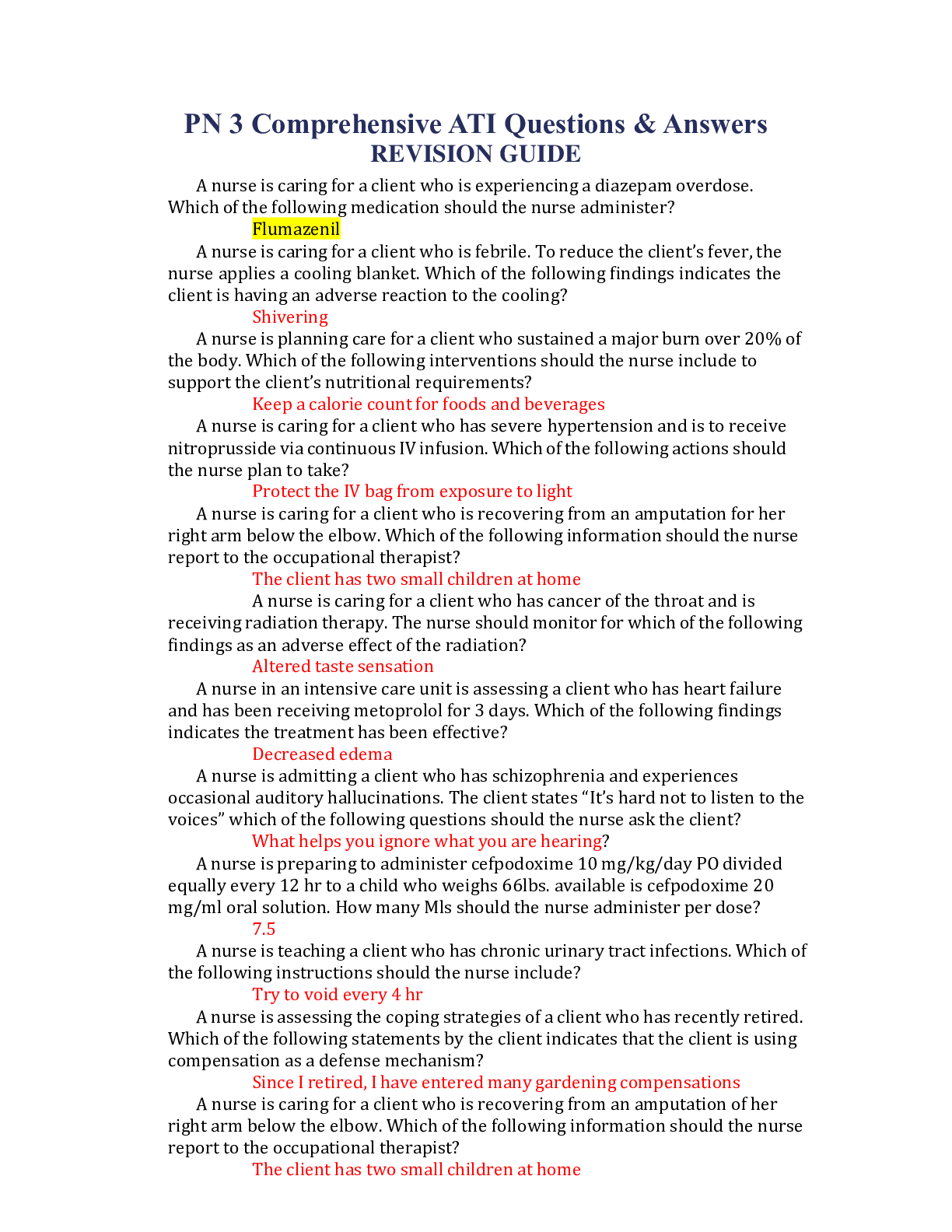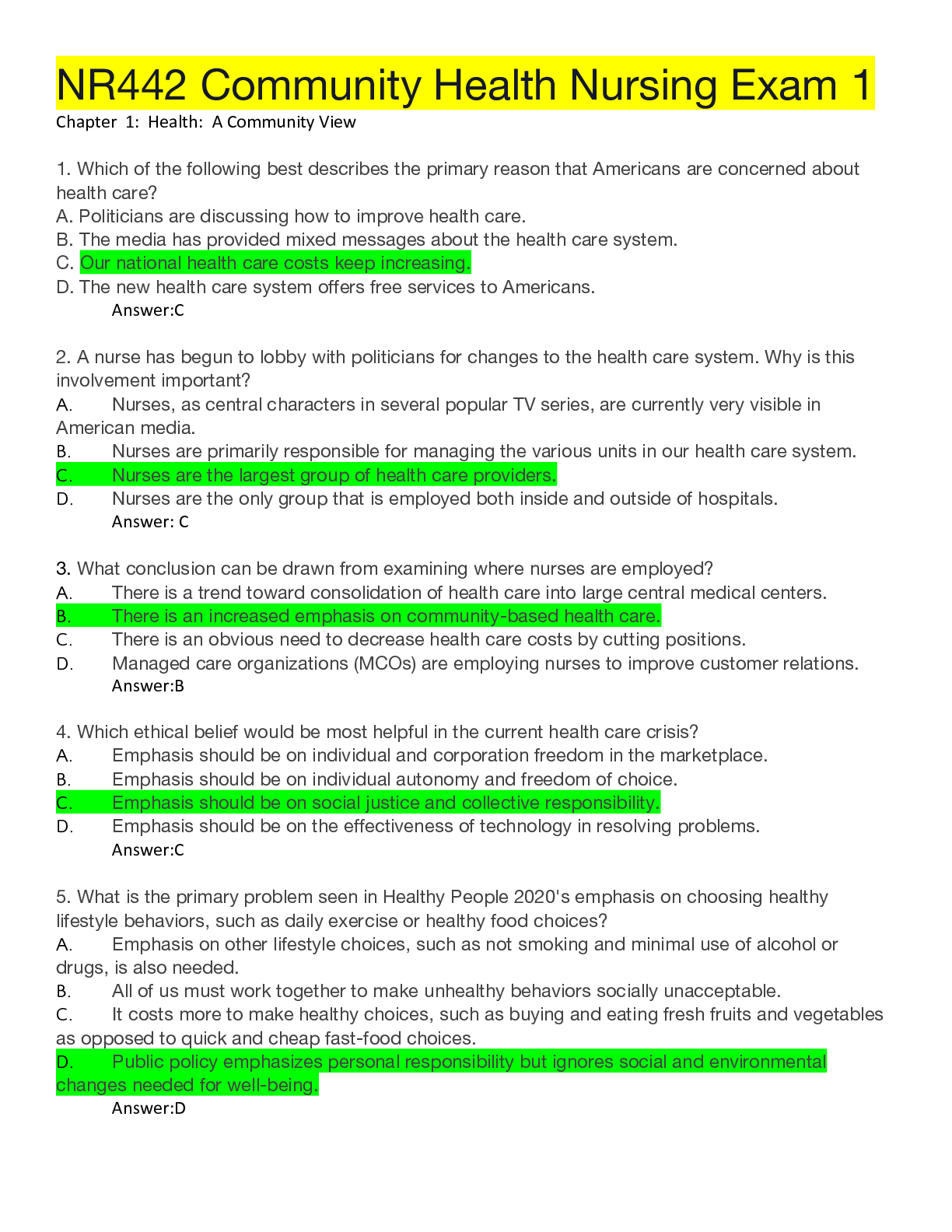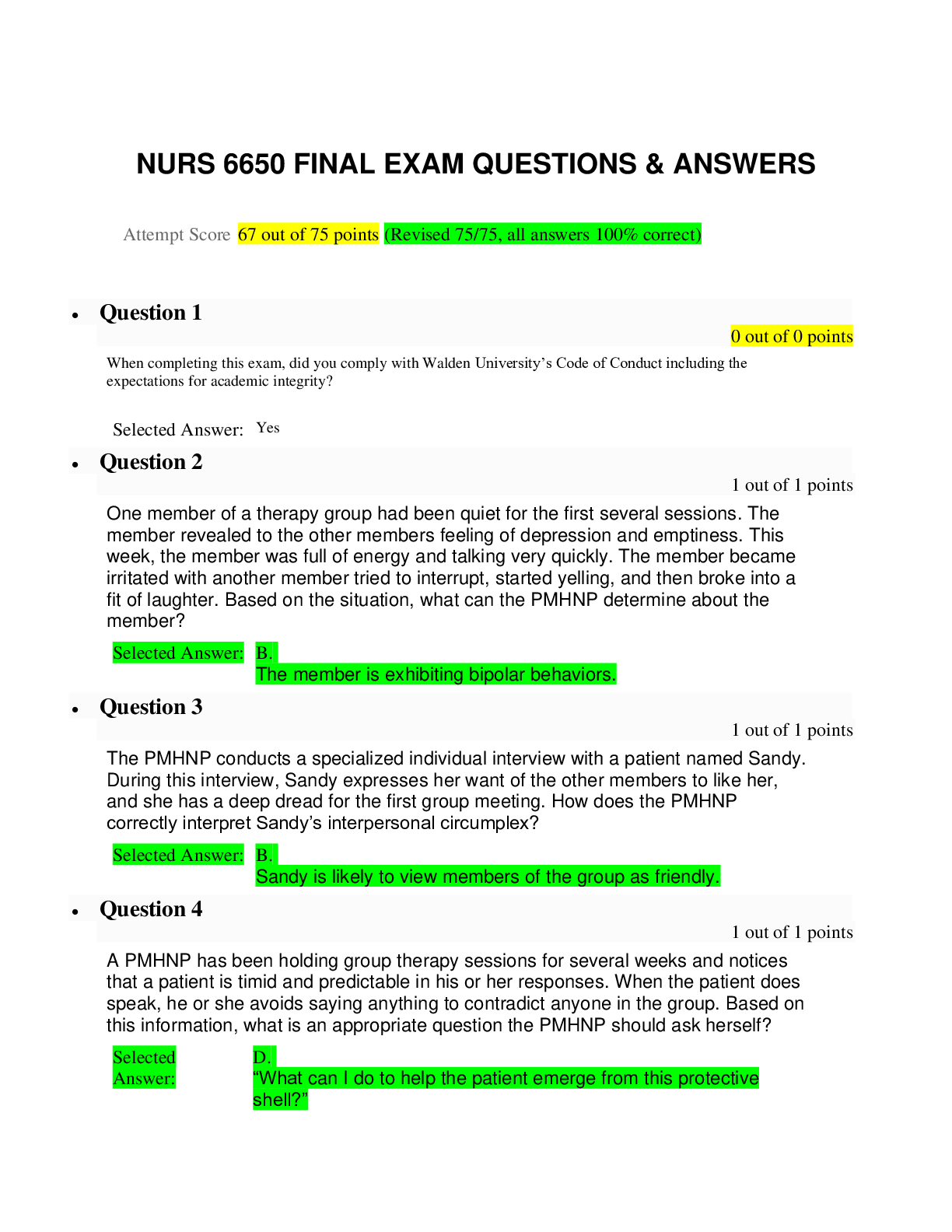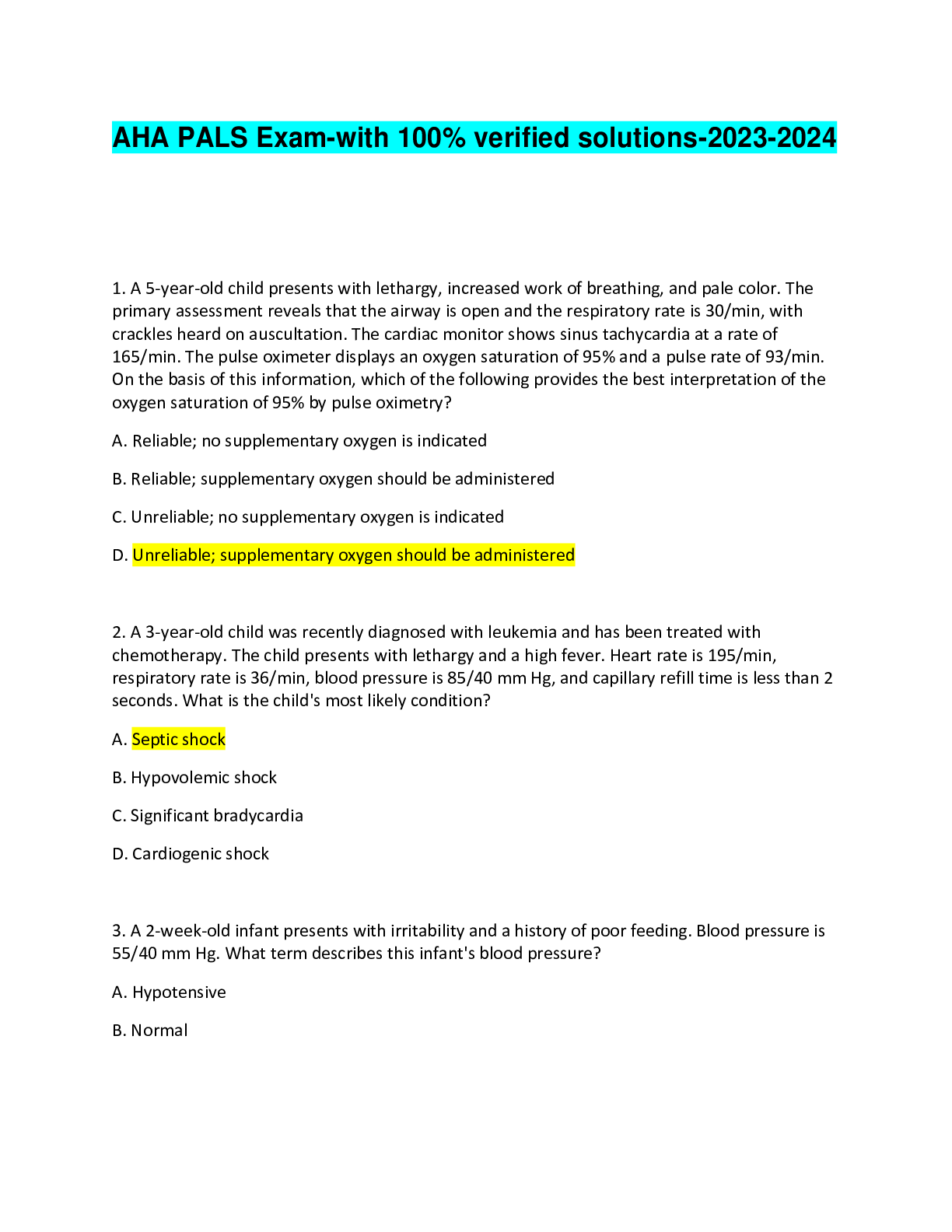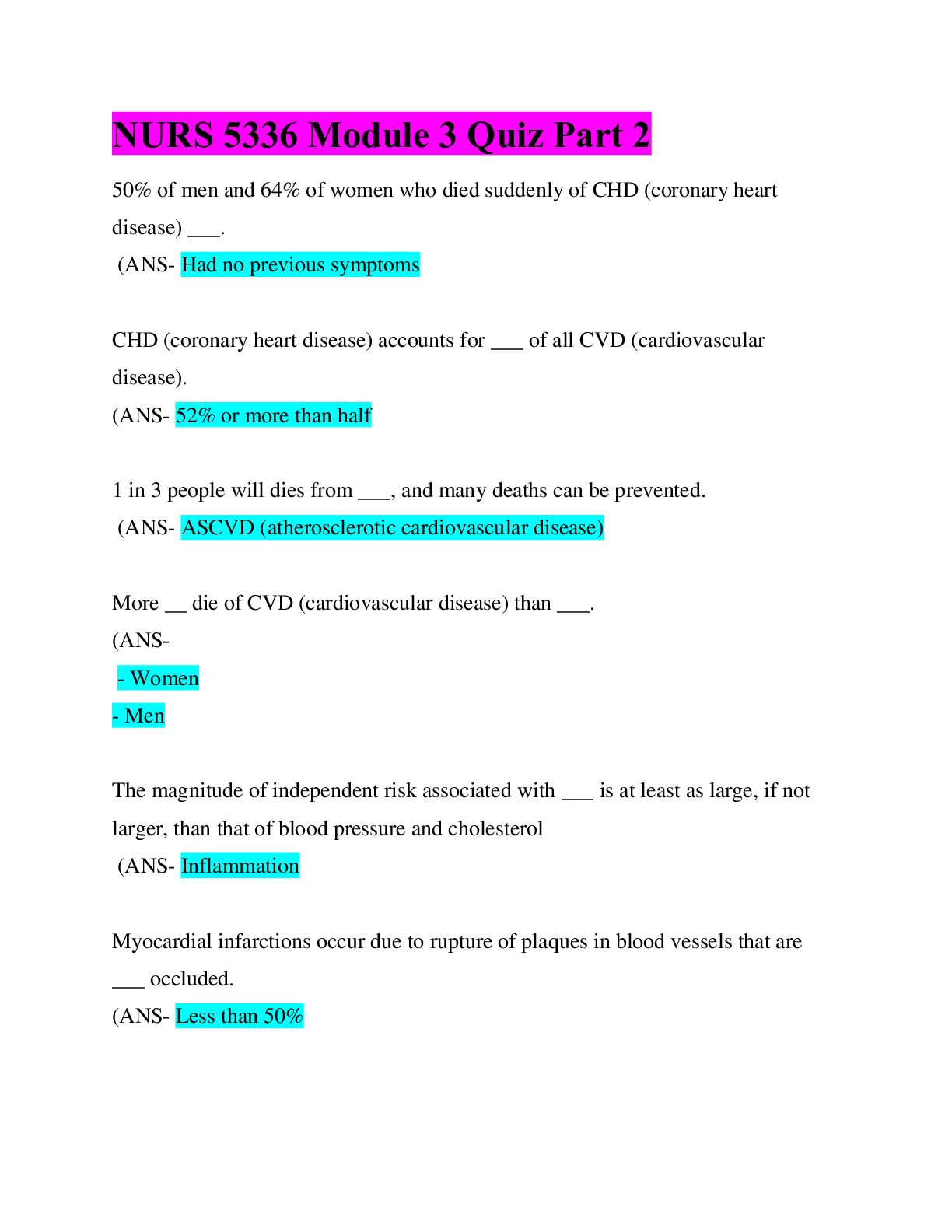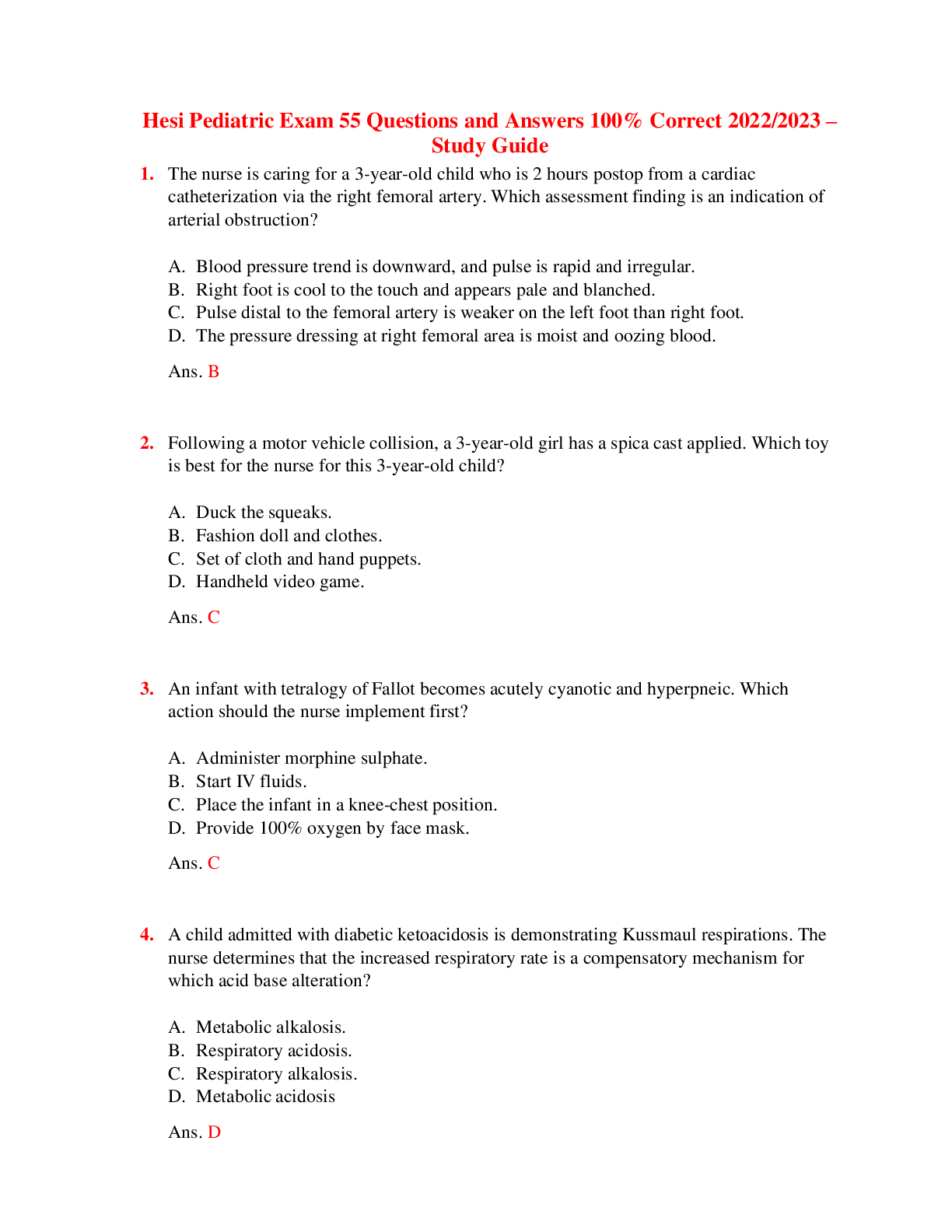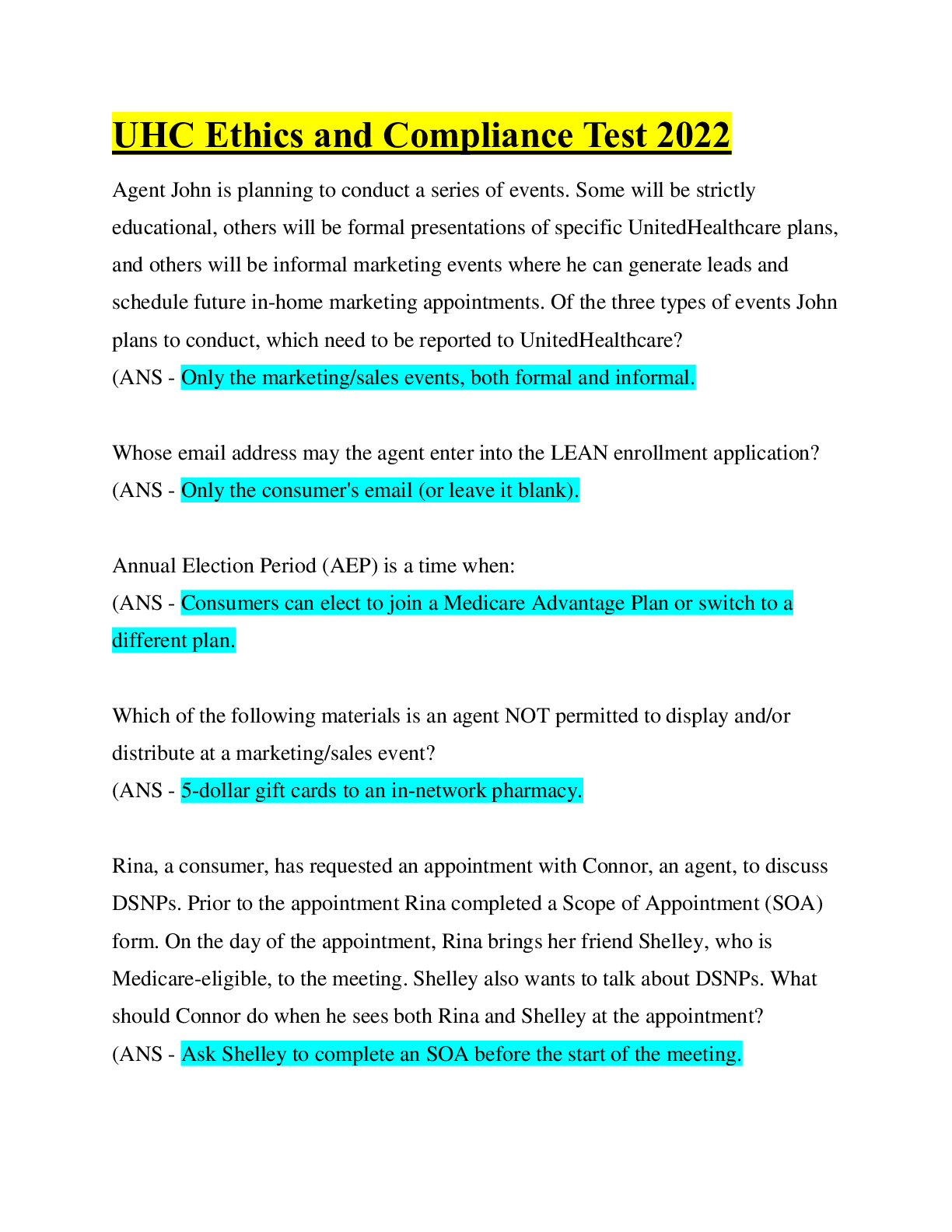AHA PALS Practice exam / AHA PALS Exam Questions & Answers Fall 2021/2022
Document Content and Description Below
AHA PALS Exam Questions & Answers Fall 2021/2022. 1. A 5-year-old child presents with lethargy, increased work of breathing, and pale color. The primary assessment reveals that the airway is open and ... the respiratory rate is 30/min, with crackles heard on auscultation. The cardiac monitor shows sinus tachycardia at a rate of 165/min. The pulse oximeter displays an oxygen saturation of 95% and a pulse rate of 93/min. On the basis of this information, which of the following provides the best interpretation of the oxygen saturation of 95% by pulse oximetry? A. Reliable; no supplementary oxygen is indicated B. Reliable; supplementary oxygen should be administered C. Unreliable; no supplementary oxygen is indicated D. Unreliable; supplementary oxygen should be administered 2. A 3-year-old child was recently diagnosed with leukemia and has been treated with chemotherapy. The child presents with lethargy and a high fever. Heart rate is 195/min, respiratory rate is 36/min, blood pressure is 85/40 mm Hg, and capillary refill time is less than 2 seconds. What is the child's most likely condition? A. Septic shock B. Hypovolemic shock C. Significant bradycardia D. Cardiogenic shock 3. A 2-week-old infant presents with irritability and a history of poor feeding. Blood pressure is 55/40 mm Hg. What term describes this infant's blood pressure? A. Hypotensive B. Normal C. Hypertensive D. Compensated 4. During a resuscitation attempt, the team leader orders an initial dose of epinephrine at 0.1 mg/kg to be given 10. What should the team member do? A. Administer the drug as ordered B. Administer 0.01 mg/kg of epinephrine C. Respectfully ask the team leader to clarify the dose D. Refuse to administer the drug 5. Which of the following is a characteristic of respiratory failure? A. Inadequate oxygenation and/or ventilation B. Hypotension C. An increase in serum pH (alkalosis) D. Abnormal respiratory sounds 6. Which of the following is most likely to produce a prolonged expiratory phase and wheezing? A. Disordered control of breathing B. Hypovolemic shock C. Lower airway obstruction D. Upper airway obstruction 7. A 4-year-old child presents with seizures and irregular respirations. The seizures stopped a few minutes ago. Which of the following most likely to be abnormal? A. Vascular resistance B. Pulse rate C. Lung compliance D. Control of breathing 8. What abnormality is most likely to be present in children with acute respiratory distress caused by lung tissue disease? A. Decreased oxygen saturation B. Stridor C. Normal respiratory rate D. Decreased respiratory effort 9. An alert 2-year-old child with an increased work of breathing and pink color is being evaluated. Heart rate is 110/min, and respiratory rate is 30/min. What would best describe this patient's condition? A. Respiratory distress B. Respiratory arrest C. Respiratory failure D. Disordered control of breathing 10. The parents of a 7-year-old child who is undergoing chemotherapy report that the child has been febrile and has not been feeling well, with recent onset of lethargy. Assessment reveals the following: The child is difficult to arouse, with pale color. The child's heart rate is 160/min, respiratory rate is 30/min, blood pressure is 76/45 mm Hg, capillary refill time is 5 to 6 seconds, and temperature is 103°F (39.4°C). What is the most appropriate intervention? A. Obtain vascular access and administer 20 mL/kg of isotonic crystalloid over 30 minutes B. Obtain vascular access and administer 20 mL/kg of isotonic crystalloid over 5 to 10 minutes C. Obtain immediate blood cultures and chest x-ray D. Obtain expert consultation with an oncologist to determine the chemotherapeutic regimen 11. A 2-year-old child presents with a 4-day history of vomiting. The initial impression reveals an unresponsive child with intermittent apnea and mottled color. Heart rate is 166/min, respiratory rate is now being supported with bag-mask ventilation, capillary refill time is 5 to 6 seconds, and temperature is 102°F (38.9°C). What is the best method of establishing immediate vascular access? A. Two providers may attempt peripheral vascular access twice each B. Three providers may attempt peripheral vascular access once each C. Place a central venous line D. Place an intraosseous line 12. What is the appropriate fluid bolus to administer for a child with hypovolemic shock with adequate myocardial function? A. 10 mL/kg normal saline B. 20 mL/kg of 5% dextrose and 0.2% sodium chloride C. 20 mL/kg normal saline D. 10 mL/kg lactated Ringer's 13. An alert toddler presents with a barking cough, moderate stridor, and moderate retractions. The child's color is pink. What is the most appropriate initial intervention? A. Obtain a chest radiograph B. Administer nebulized epinephrine C. Prepare for a surgical airway D. Use an epinephrine autoinjector 14. An 8-year-old child presents with a history of vomiting and diarrhea. The child has the following vital signs: heart rate 168/min, respiratory rate 15/min, blood pressure 9060 mm Hg, and temperature 98.6°F (37°C). The child's capillary refill time is 4 seconds. After 2 IV boluses of normal saline (20 mL/kg each), the child's vital signs are now as follows: heart rate 130/min, respiratory rate 16/min, blood pressure 94/62 mm Hg, capillary refill 2 seconds, and temperature 98.6°F (37°C). The child's urine output is 1 to 2 mL/kg in the past hour. The child is still lethargic. What diagnostic tests or information should be obtained first? A. Arterial blood gas B. Serum potassium concentration C. Glucose D. A 12-lead ECG 15. A 15-year-old boy presents with acute onset of severe respiratory distress, with retractions and an oxygen saturation of 85%. His trachea is deviated to the right, and there are no breath sounds on the left. His heart rate is 140/min, his blood pressure is 84/60 mm Hg, and his capillary refill time is 3 seconds. What is the most appropriate intervention? A. Obtain a chest x-ray B. Perform needle decompression on the left chest C. Insert a chest tube on the left side D. Insert an IV and administer 20 mL/kg of normal saline 16. A 4-year-old is being treated for hypovolemic shock and has received a single fluid bolus of 20 mL/kg of normal saline. On reevaluation the child remains anxious, with a heart rate of 140/min, a blood pressure of 84/54 mm Hg, and a capillary refill time of 4 seconds. What describes this patient's condition? A. Hypotensive shock B. Compensated shock C. No longer in shock D. Cardiogenic shock 17. An 8-year-old child had a sudden onset of palpitations and light-headedness. At the time of evaluation the child is alert. His respiratory rate is 26/ min, and his blood pressure is 104/70 mm Hg. A cardiac monitor is applied, and the rhythm below is noted. What is the most appropriate initial intervention? A. Provide synchronized cardioversion at 0.5 to 1 J/kg B. Attempt vagal maneuvers C. Administer adenosine 0.1 mg/kg over 5 minutes D. Administer amiodarone 5 mg/kg over 20 minutes 18. A 10-year-old child had a sudden witnessed cardiac arrest and received immediate bystander CPR and defibrillation within 3 minutes. He had a return of spontaneous circulation. The child remains unresponsive and has an advanced airway in place. There is no history of trauma or signs of shock. What is the target range for oxygen saturation for this child? A. 92% to 100% B. 92% to 99% C. 94% to 99% D. 94% to 100% 19. A 3-month-old infant with bronchiolitis is suctioned to remove upper airway secretions. The infant's heart rate decreases from 155/min to 65/min as shown below. The infant remains alert, with easily palpable pulses. Capillary refill time is 1 second. What is the most appropriate initial intervention? A. Administer oxygen and ensure adequate ventilation; be prepared to intervene further if heart rate does not increase B. Establish IV/IO access and administer epinephrine 0.01 mg/kg IV C. Establish IV/IO access and administer atropine 0.02 mg/kg IV D. Call for help and prepare to provide transthoracic pacing/transvenous pacing 20. A 3-month-old infant with bronchiolitis is intubated for management of respiratory failure. During transport, the infant develops bradycardia with a heart rate of 60/min, and the infant's oxygen saturation decreases to 75%. There are breath sounds on the right side, but no air entry is heard on the left side. What is the most appropriate initial intervention? A. Administer epinephrine 0.01 mg/kg IV B. Place a chest tube on the left C. Verify the endotracheal tube position D. Aggressively suction the endotracheal tube 21. For a 6-month-old infant with supraventricular tachycardia and adequate perfusion, which of the following is the preferred vagal maneuver? A. Ocular pressure B. Carotid pressure C. Valsalva maneuver D. Ice to the face 22. A child presents with severe respiratory distress, urticaria, stridor, and tachycardia about 10 minutes after eating peanuts. What is the most appropriate initial medication for this child? A. Nebulized albuterol B. Epinephrine IM C. Isotonic crystalloid IV D. Methylprednisolone 23. A 2-year-old child was found submerged in a swimming pool. She is unresponsive, not breathing, and pulseless. In addition to performing high-quality CPR and establishing vascular access, which of the following is the most appropriate intervention? A. Give atropine 0.02 mg/kg lIO/IV B. Apply cricoid pressure C. Give epinephrine 0.01 mg/kg IO/IV D. Provide transthoracic pacing 24. A 3-year-old child is unresponsive, not breathing, and pulseless. High-quality CPR is in progress. A cardiac monitor is applied, and the rhythm below is noted. What is the next appropriate intervention? A. Attempt defibrillation with a 2 J/kg shock B. Administer epinephrine 0.01 mg/kg C. Consider placement of an advanced airway D. Administer amiodarone 5 mg/kg 25. A pulseless 6-week-old infant arrives in the emergency department, and high-quality CPR is in progress. The initial rhythm strip is shown below. CPR continues, and vascular access has been established. What is the next appropriate intervention? A. Administer atropine 0.02 mg/kg IO/IV B. Attempt defibrillation with a 2 J/kg shock C. Administer epinephrine 0.01 mg/kg IO/IV D. Consider insertion of an advanced airway 26. A 6-month-old infant is unresponsive and not breathing. What is the maximum time that should be spent trying to palpate the pulse before starting CPR? A. 10 seconds B. 15 seconds C. 30 seconds D. 60 seconds 27. What is the recommended location to check for a pulse in a 3- month-old infant? A. Carotid B. Radial C. Brachial D. Cardiac apex 28. A 7-year-old child presents in pulseless arrest. The child's ECG shows the rhythm below. Which of the following describes the patient's condition? A. Ventricular escape rhythm B. Ventricular tachycardia C. Pulseless electrical activity D. Sinus bradycardia 30. A 12-year-old child suddenly collapses while playing sports. He is unresponsive and not breathing. Emergency response is activated. The child has no pulse, and CPR is initiated. An AED arrives. What is the most appropriate next intervention? A. Contact the child's family B. Provide CPR for 2 minutes C. Drive the child to the hospital D. Use the AED 31. A 6-year-old child is found unresponsive, not breathing, and pulseless. What is the correct compression-to-ventilation ratio when 2 or more healthcare providers are present to perform CPR? 32. A 5-year-old child has had severe respiratory distress for 2 days. During assessment the child's heart rate decreases from 140/min to 90/min, and the child's respiratory rate decreases from 66/min to 8/min. What intervention is most appropriate? A. Provide rescue breaths at a rate of 12 to 20/min B. Provide rescue breaths at a rate of 6 to 10/min C. Initiate chest compressions at a rate of at least 100/min D. Initiate chest compressions at a rate of 60/min 33. A 7-year-old child presents with a narrow-complex supraventricular tachycardia, lethargy, and poor perfusion. Pulses are weak and thready. Vascular access cannot be established. What is the most appropriate intervention? A. Unsynchronized shock with 0.5 to 1 J/kg B. Synchronized shock with 0.5 to 1 J/kg C. Unsynchronized shock with 2 J/kg D. Synchronized shock with 2 J/kg 1. A 13-year-old patient with asthma just received oxygen and albuterol via a nebulizer. What is the next most appropriate intervention? A. Administer 0.1 mg/kg of adenosine B. Obtain a blood sample to evaluate arterial or venous blood gases C. Reassess breath sounds and clinical status D. Repeat the albuterol treatment 2. The respiratory rate of a 1-year-old child with respiratory distress has decreased from 65/min to 30/min. The child is more lethargic and continues to have subcostal retractions. What does this change likely indicate? A. Respiratory distress is unchanged B. Progression toward respiratory failure C. Improved respiratory status D. Neurologic impairment 3. What is the most likely cause of head bobbing in infants? A. Increased respiratory effort B. Improving respiratory status C. Decompensated shock D. Brain injury 4. Several healthcare providers are participating in an attempted resuscitation. Which of the following is most consistent with the responsibilities of the team leader of the resuscitation? A. Records medications and interventions B. Assigns roles to team members C. Administers defibrillation shocks D. Provides compressions 5. Which of the following conditions is appropriate for use of an oropharyngeal airway? A. Conscious with no gag reflex B. Unconscious with a gag reflex C. Unconscious with no gag reflex D. Conscious with a gag reflex 7. A child presents with severe respiratory distress, urticaria, stridor, and tachycardia about 10 minutes after eating peanuts. What is the most appropriate initial medication for this child? A. Nebulized albuterol B. Epinephrine IM C. Isotonic crystalloid IV D. Methylprednisolone IV 8. A mother brings her 7-year-old child to the emergency department. The mother states that the child has had a fever for the past 4 days and has had little to eat or drink during the past 24 hours. Your initial impression reveals a lethargic child with increased respiratory rate and pale color. Heart rate is 160/min, respiratory rate is 38/min, and blood pressure is 86/48 mm Hg. Capillary refill is 4 seconds. Which of the following is the most appropriate intervention for this child? A. Fluid bolus of 10 mL/kg of isotonic crystalloid B. Fluid bolus of 20 mL/kg of isotonic crystalloid C. Maintenance fluid infusion of isotonic crystalloid at 10 mL/h D. Maintenance fluid infusion of 5% dextrose and water at 20 mL/h 9. An intubated 5-year-old child who was in a motor vehicle collision becomes increasingly more difficult to ventilate. The child has diminished breath sounds and chest expansion on the right side of the chest, with audible breath sounds and visible chest expansion on the left. The endotracheal tube insertion depth has not changed. What is the most appropriate intervention? A. Deflate the cuff and pull the tube back B. Perform needle decompression on the right chest C. Perform needle decompression on the left chest D. Insert a gastric tube 10. A 2-year-old child with a 2-day history of a barking cough presents with audible stridor on inspiration, intercostal retractions, and agitation. What is the most appropriate intervention for this child? A. Lay the child flat on a stretcher B. Suction the mouth and nose C. Administer nebulized epinephrine D. Administer inhaled albuterol 11. Which of the following oxygen saturations indicates the need for additional intervention? A. 96% on room air B. 95% on room air C. 93% on 4 L of oxygen D. 97% on 50% oxygen 12. A 3-year-old child presents with a 2-day history of nausea and vomiting. She is alert, with no increase in respiratory effort, and is pale in color. The child's heart rate is 160/min, respiratory rate is 40/min, and blood pressure is 100/70 mm Hg. Her extremities are cool, with sluggish capillary refill. Which term best describes this child's physiologic state? A. Compensated shock B. Cardiogenic shock C. Hypotensive shock D. Obstructive shock 13. A 3-year-old child presents with dehydration after a 2-day history of vomiting and diarrhea. The child after has received 2 fluid boluses of 20 mL/ kg of normal saline. After the second bolus, the child is alert and interacting. Her heart rate is 110/ min, respiratory rate is 30/min, and blood pressure is 92/64 mm Hg. Her capillary refill time is 2 seconds, and oxygen saturation is 98%. What is the most appropriate next intervention for this child? A. Administer another 20 mL/kg normal saline fluid bolus B. Administer 10 mL/kg of packed red cells C. Continue to monitor and reevaluate the child D. Initiate a dopamine drip of 20 mcg/kg per minute 14. A 3-year-old child presents with a high fever and a petechial rash. The child is lethargic, has no signs of increased work of breathing, and is pale in color. His heart rate is 180/min, respiratory rate is 30/min, blood pressure is 80/68 mm Hg. Capillary refill time is 4 seconds, and oxygen saturation is 88%. Airway and lungs are clear. Peripheral pulses are diminished. Which of the following is the most appropriate initial intervention? A. Provide 100% oxygen via a nonrebreathing mask B. Obtain IV access C. Administer dopamine D. Administer an antibiotic 16. An alert toddler presents with a barking cough, moderate stridor, and moderate retractions. The child's color is pink. What is the most appropriate initial intervention? A. Obtain a chest radiograph B. Administer nebulized epinephrine C. Prepare for a surgical airway D. Use an epinephrine autoinjector 17. The initial impression of a 4-year-old child reveals a lethargic child who is diaphoretic, with no increased work of breathing and pink color. Her heart rate is 220/min, respiratory rate is 24/min, blood pressure is 84/46 mm Hg, and capillary refill time is 5 seconds. IV access has been established. The rhythm below is seen on the cardiac monitor. What is the most appropriate initial intervention? A. Give adenosine 0.1 mg/kg rapid IV push B. Perform carotid sinus massage C. Perform synchronized cardioversion at 0.5 J/kg D. Attempt defibrillation at 2 J/kg 18. An 8-month-old infant is being evaluated. The child's mother says the infant has not been feeding well. The infant is alert with rapid but unlabored breathing, and the infant's color is pale. A cardiac monitor is applied, and the rhythm below is noted. Distal pulses are readily palpable. You give oxygen and establish IV access. What is the most appropriate vagal maneuver? A. Valsalva maneuver B. Carotid massage C. Ocular pressure D. Ice to the face 19. A 7-year-old child presents with a narrow-complex supraventricular tachycardia, lethargy, and poor perfusion. Pulses are weak and thready. Vascular access cannot be established. What is the most appropriate intervention? A. Unsynchronized shock with 0.5 to 1 J/kg B. Synchronized shock with 0.5 to 1 J/kg C. Unsynchronized shock with 2 J/kg D. Synchronized shock with 2 J/kg 20. A 3-month-old infant presents with lethargy and a 3-day history of vomiting, diarrhea, and poor feeding. The initial impression reveals lethargy, increased respiratory effort with retractions, and pale, mottled skin color. Vital signs are as follows: heart rate 210/min, respiratory rate 60/min, and blood pressure 60/40 mm Hg. Peripheral pulses are thready, and capillary refill time is 4 seconds. The cardiac monitor displays the rhythm below. After administration of oxygen and establishment of vascular access, what is the most appropriate intervention? A. Adenosine O.1 mg/kg IV rapid push B. Vagal maneuvers C. Synchronized shock at 0.5 to 1 J/kg D. IV fluid bolus of 20 mL/kg normal saline 21. A 3-year-old child is unresponsive, gasping, and has no detectable pulse. CPR is initiated. A monitor is attached, and the rhythm is shown below. What is the appropriate next therapy? A. Attempted defibrillation with 2 J/kg B. Synchronized cardioversion with 0.5 to 1 J/kg C. Epinephrine 0.01 mg/kg 10/IV D. Amiodarone 5 mg/kg 1O/IV 22. A 2-year-old child is in pulseless arrest. The child has received high-quality CPR, 2 shocks, and a dose of IV epinephrine. The next rhythm check reveals the rhythm shown below. What would be an appropriate energy dose for the third defibrillation attempt? A. 2 J/kg B. 2 to 4 J/kg C. 4 J/kg or greater D. Greater than 10 J/kg 23. A 12-year-old child suddenly collapses while playing sports. He is unresponsive and not breathing. Emergency response is activated. The child has no pulse, and CPR is initiated. An AED arrives. What is the most appropriate next intervention? A. Contact the child's family B. Provide CPR for 2 minutes C. Drive the child to the hospital D. Use the AED 24. A 3-year-old child is in cardiac arrest, and high- quality CPR is in progress. The first rhythm check reveals the rhythm below. Defibrillation is attempted with a shock dose of 2 J/kg. After administration of the shock, what is the most appropriate next intervention? A. Resume CPR, beginning with chest compressions B. Check for a pulse C. Analyze the rhythm D. Administer epinephrine 25. Which of the following is a characteristic of respiratory failure? A. Inadequate oxygenation and/or ventilation B. Hypotension C. An increase in serum pH (alkalosis) D. Abnormal respiratory sounds 26. A 3-year-old child is in cardiac arrest, and a resuscitation attempt is in progress. The child is in ventricular fibrillation and was given a shock at 2 J/kg, followed by immediate CPR. At the next rhythm check, ventricular fibrillation is again noted on the cardiac monitor. What is the most appropriate next intervention? A. Attempt defibrillation with a 4 J/kg shock B. Attempt defibrillation with a 2 J/kg shock C. Resume CPR D. Check for a pulse for at least 10 seconds 27. CPR is in progress on a 10-month-old infant who was unresponsive and not breathing, with no palpable pulse. A cardiac monitor is applied, and sinus bradycardia at a rate of 42/min is noted. CPR is resumed, and vascular access is obtained. Which of the following is the most appropriate intervention? A. Epinephrine 0.01 mg/kg IO/IV B. Atropine 0.5 mg/kg IO/IV C. Amiodarone 5 mg/kg IO/IV D. Lidocaine 1 mg/kg IO/IV 28. During a pediatric resuscitation attempt, what is most likely to contribute to high-quality CPR? A. A depth of compressions of about one fourth the anterior-posterior depth of the chest B. A compression rate of 80/min C. Pulse checks performed once per minute D. Allowing the chest wall to recoil completely between compressions 29. While you are performing CPR on an infant in cardiac arrest at a doctor's office, a second rescuer arrives with an AED. Which of the following best describes the use of an AED on this infant? A. The use of AEDS is not recommended on an infant. B. There are not enough data to recommend for or against the use of AEDS on infants. C. Only pediatric pads may be used on infants. D. If pediatric pads are unavailable, it is acceptable to use adult pads. 30. A 5-year-old child is hit in the chest with a baseball and suddenly collapses. High-quality CPR is being performed. When the AED arrives, only adult AED pads are available. What should the rescuer do? A. Use the AED with adult pads B. Wait for pediatric AED pads and use them as soon as they are available C. Continue the steps of CPR for 2 minutes before using the AED D. Await arrival of a manual defibrillator 31. A team is attempting to resuscitate a child who was brought to the emergency department by EMS after a traumatic injury. The family members arrive at the child's bedside and request to remain in the room during the resuscitation attempt. What does the American Heart Association recommend? A. Allow the family to stay at the bedside alone, but they should not talk to anyone B. Allow the family to stay at the bedside with a staff member who is assigned to provide information and assistance C. Escort the family to an assigned family room where they can be given regular updates D. Take the family to the chapel or an assigned quiet room so they can receive expert consultation. 32. Which of the following is most likely to produce a prolonged expiratory phase and wheezing? A. Disordered control of breathing B. Hypovolemic shock C. Lower airway obstruction D. Upper airway obstruction 33. A 5-year-old child has had severe respiratory distress for 2 days. During assessment the child's heart rate decreases from 140/min to 90/min, and the child's respiratory rate decreases from 66/min to 8/min. Which of the following is the next appropriate intervention? A. Rescue breaths at a rate of 12 to 20/min B. Rescue breaths at a rate of 6 to 10/min C. Chest compressions at a rate of at least 100/min D. Chest compressions at a rate of 60/min [Show More]
Last updated: 1 year ago
Preview 1 out of 19 pages

Reviews( 0 )
Document information
Connected school, study & course
About the document
Uploaded On
Feb 20, 2022
Number of pages
19
Written in
Additional information
This document has been written for:
Uploaded
Feb 20, 2022
Downloads
2
Views
183

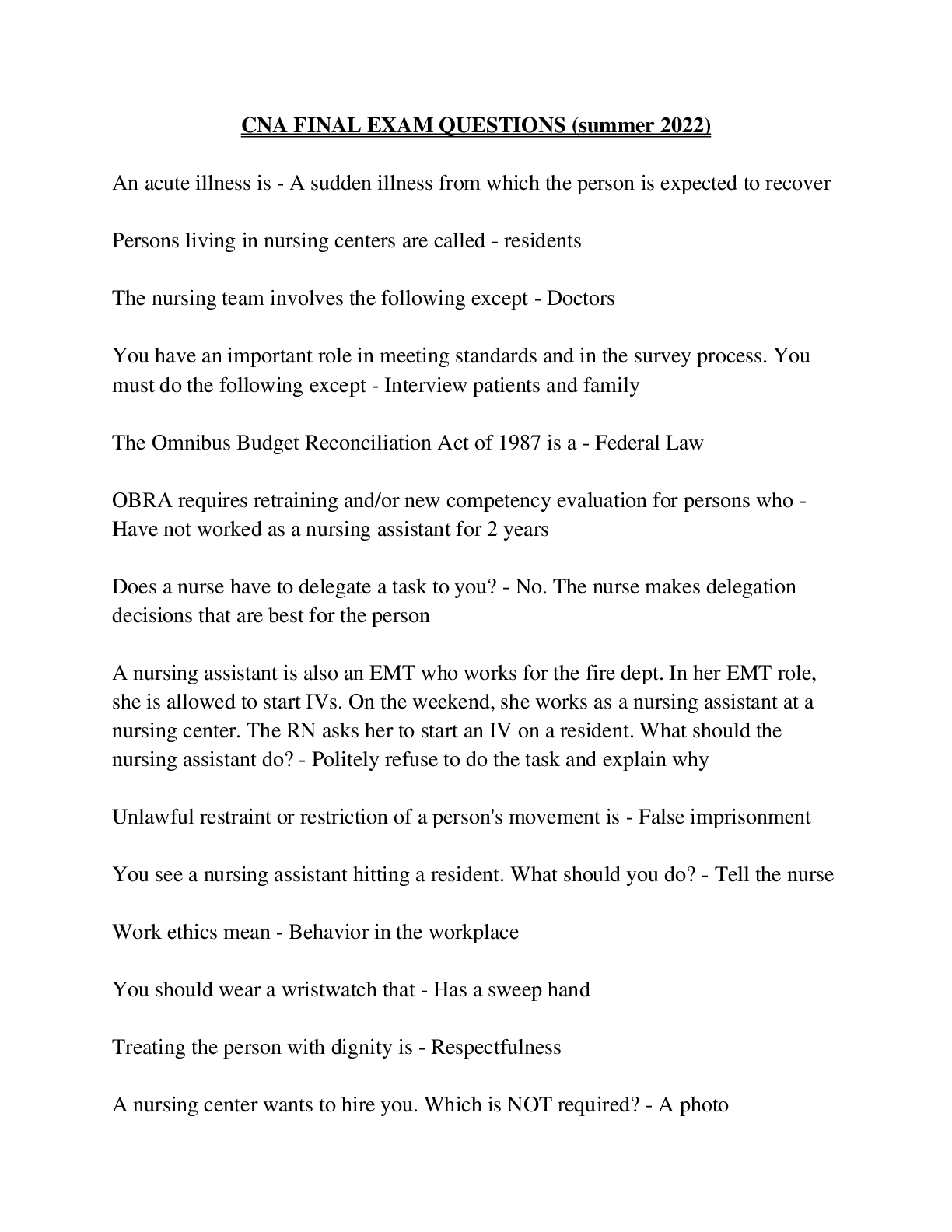
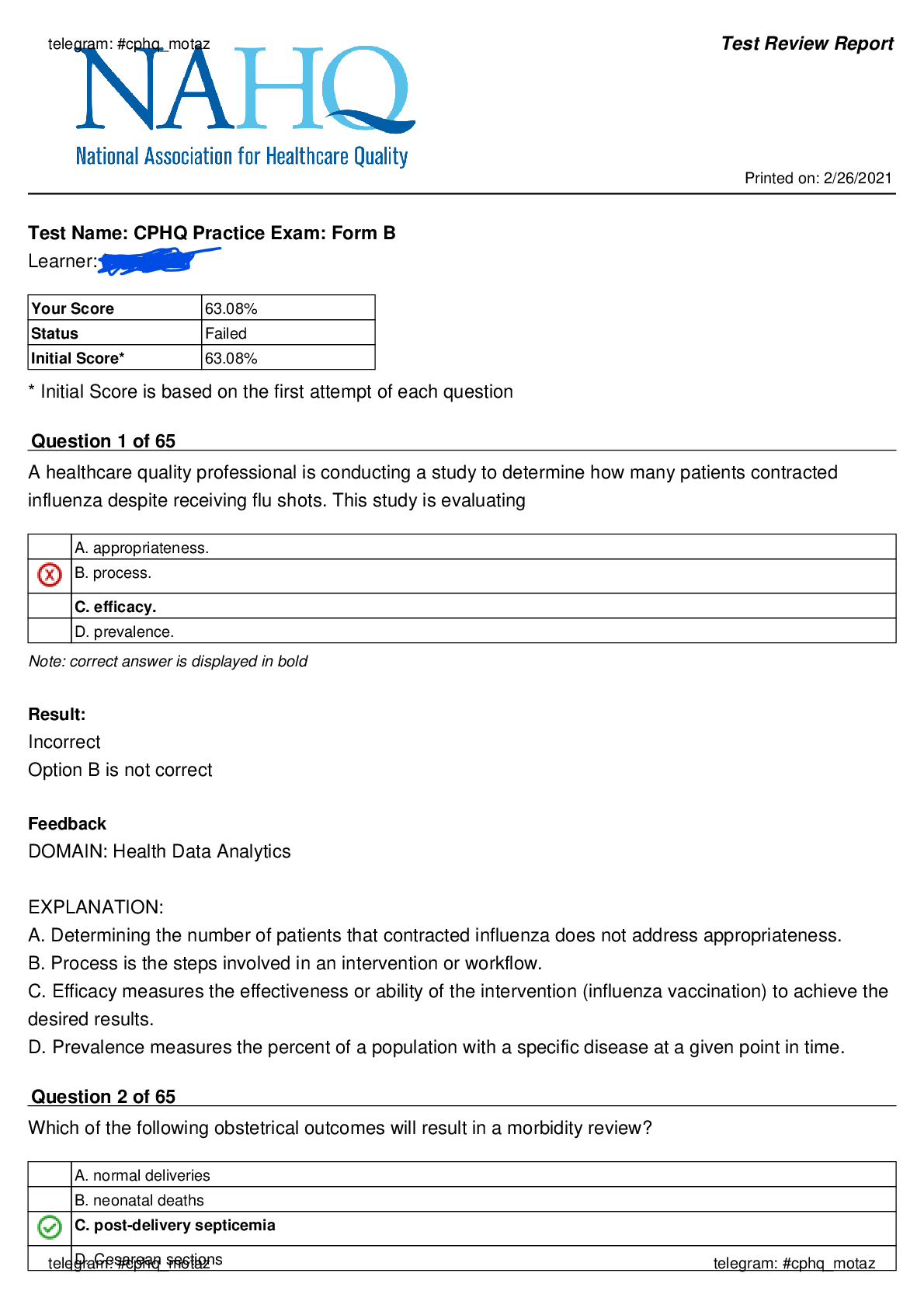

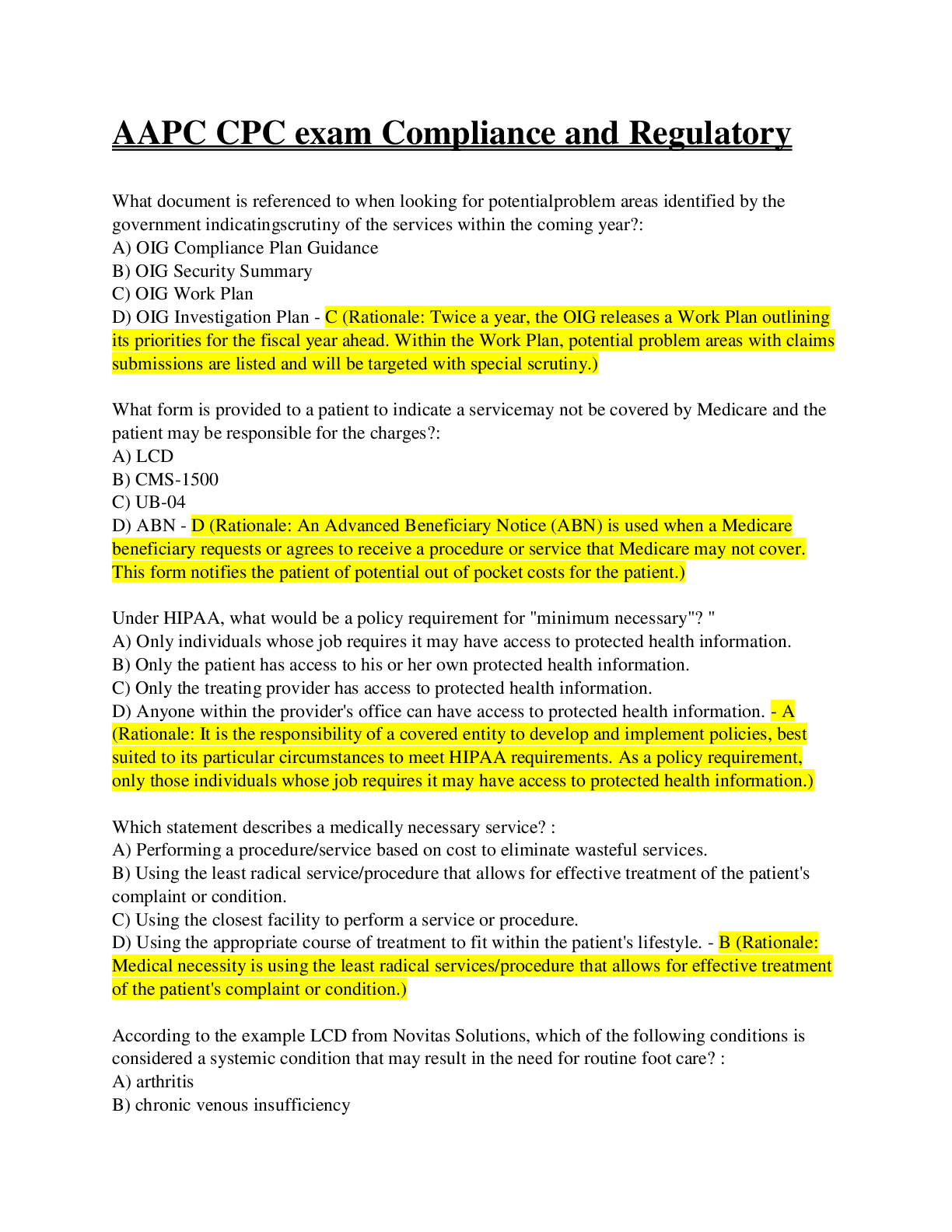
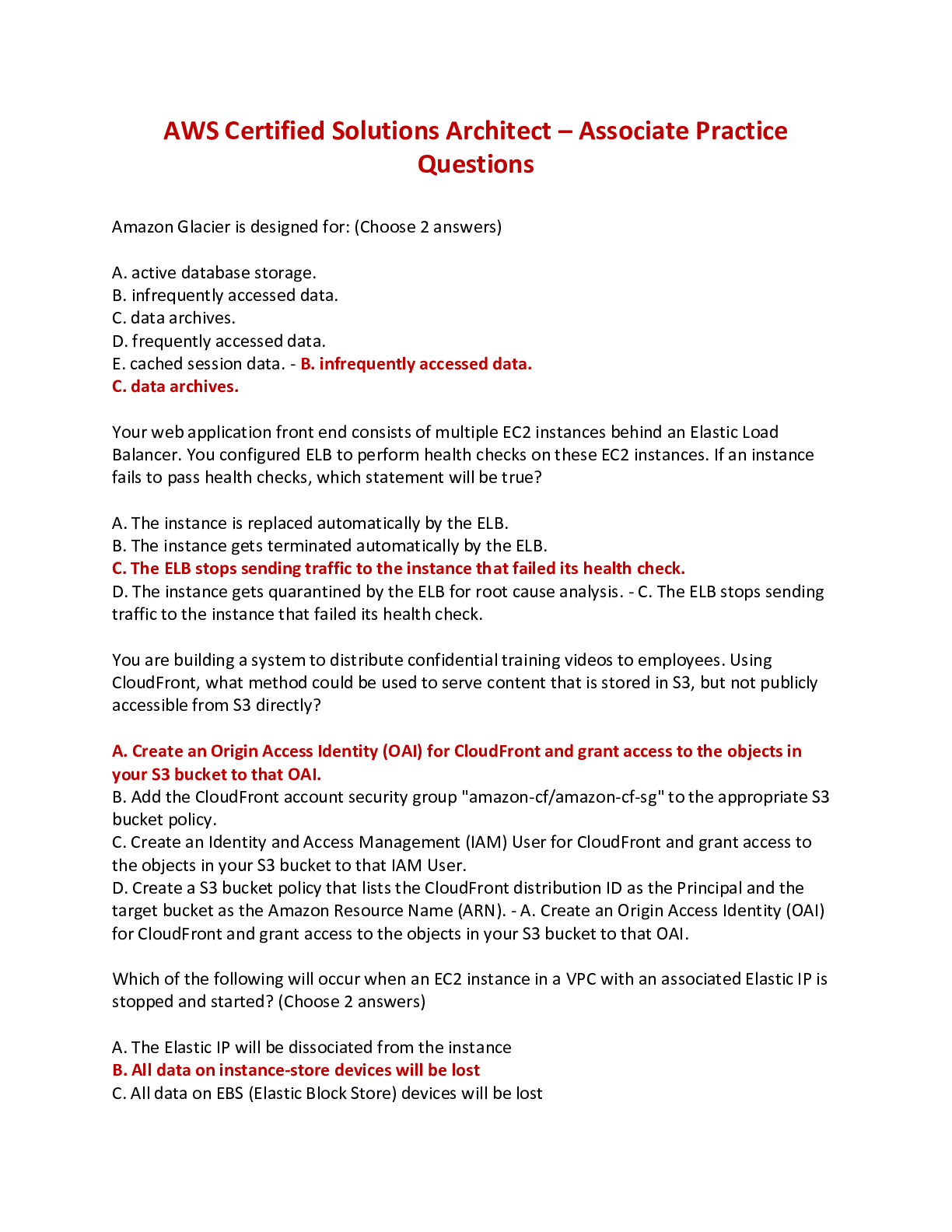
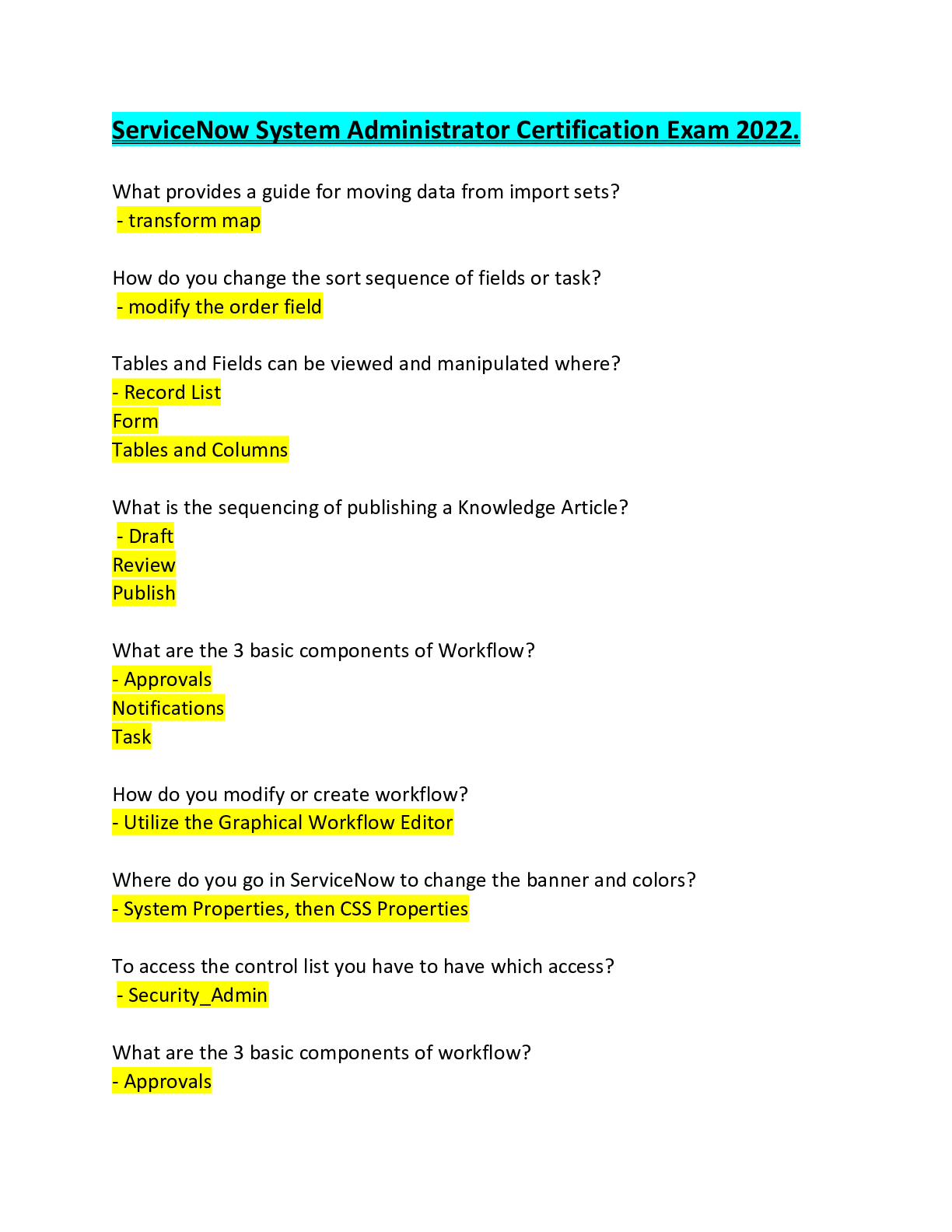

 Exam.png)


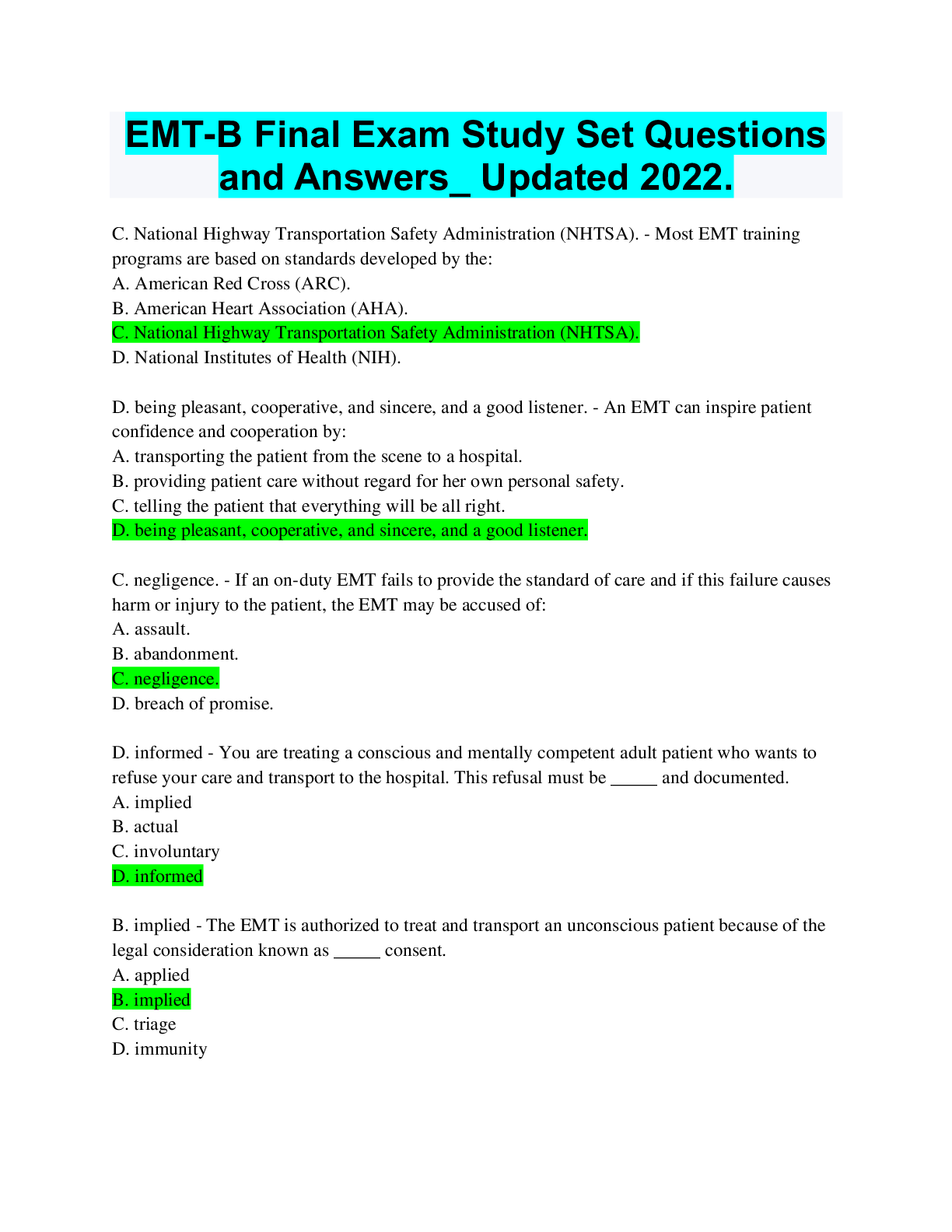
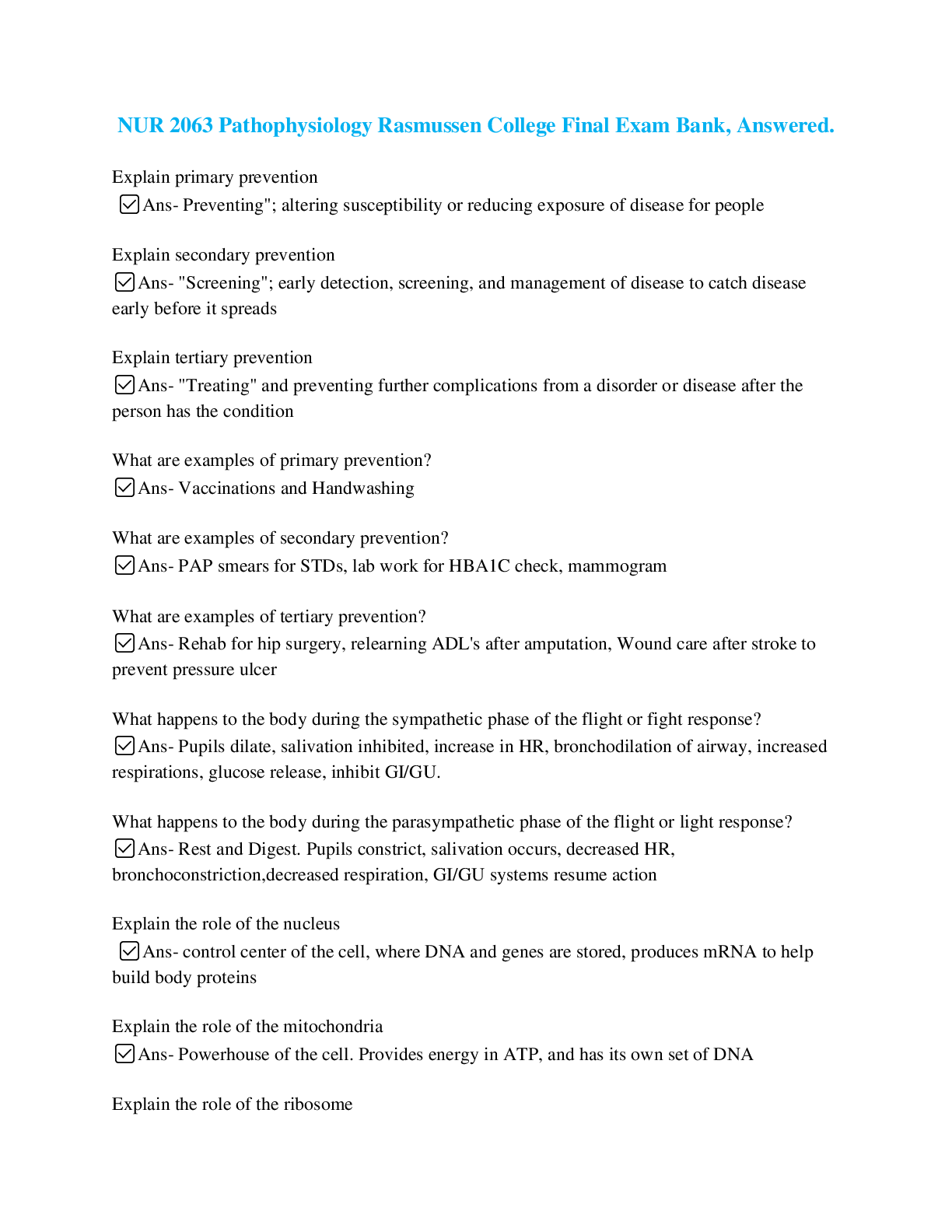
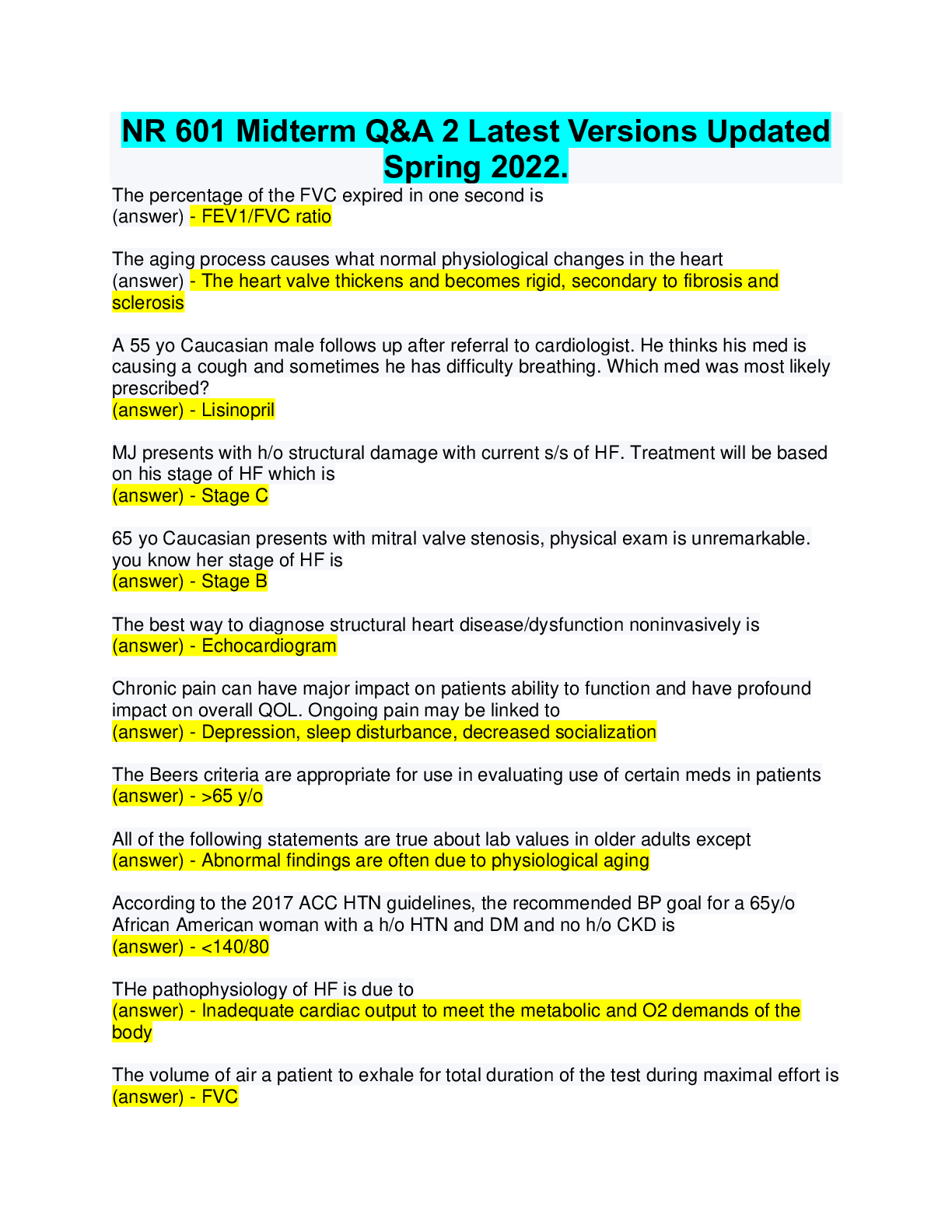

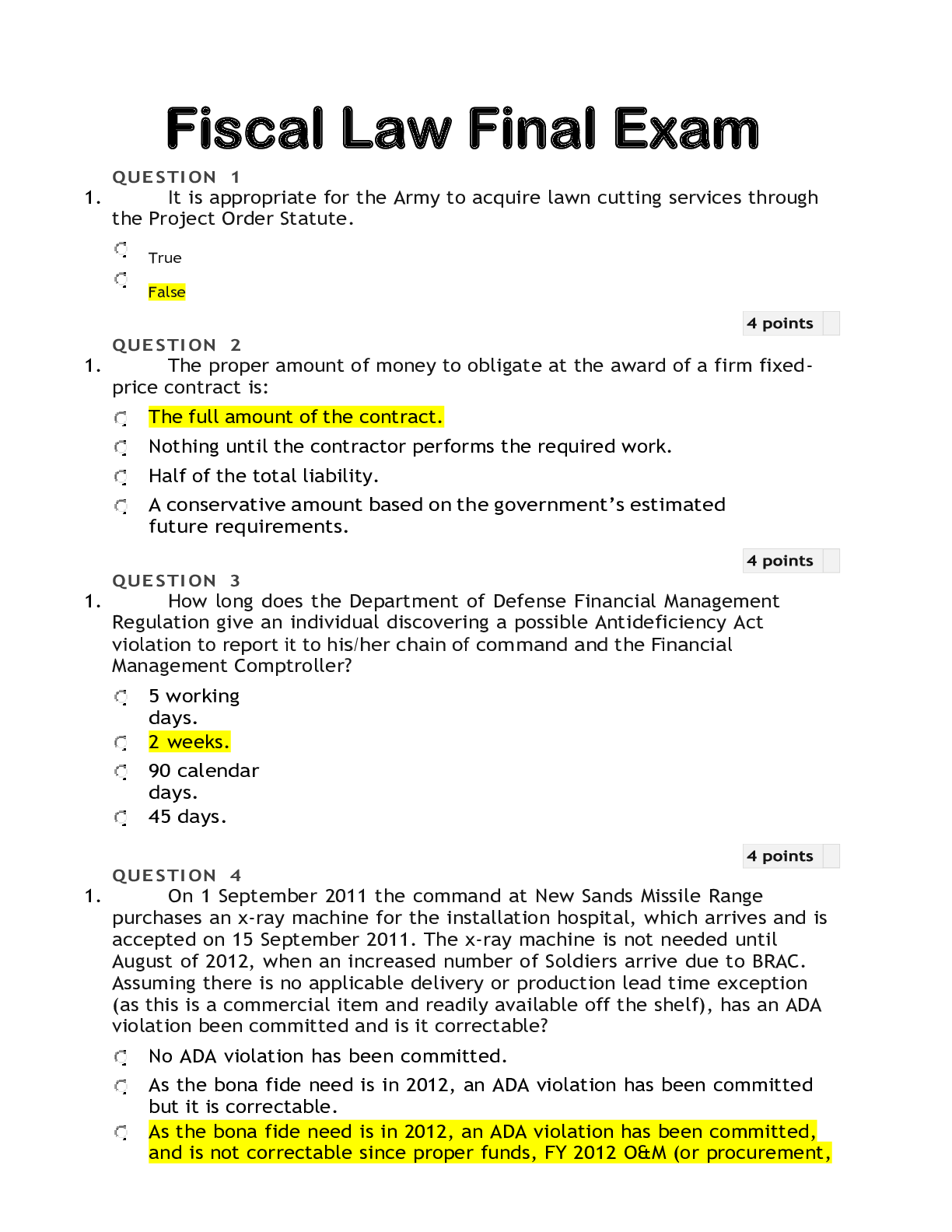

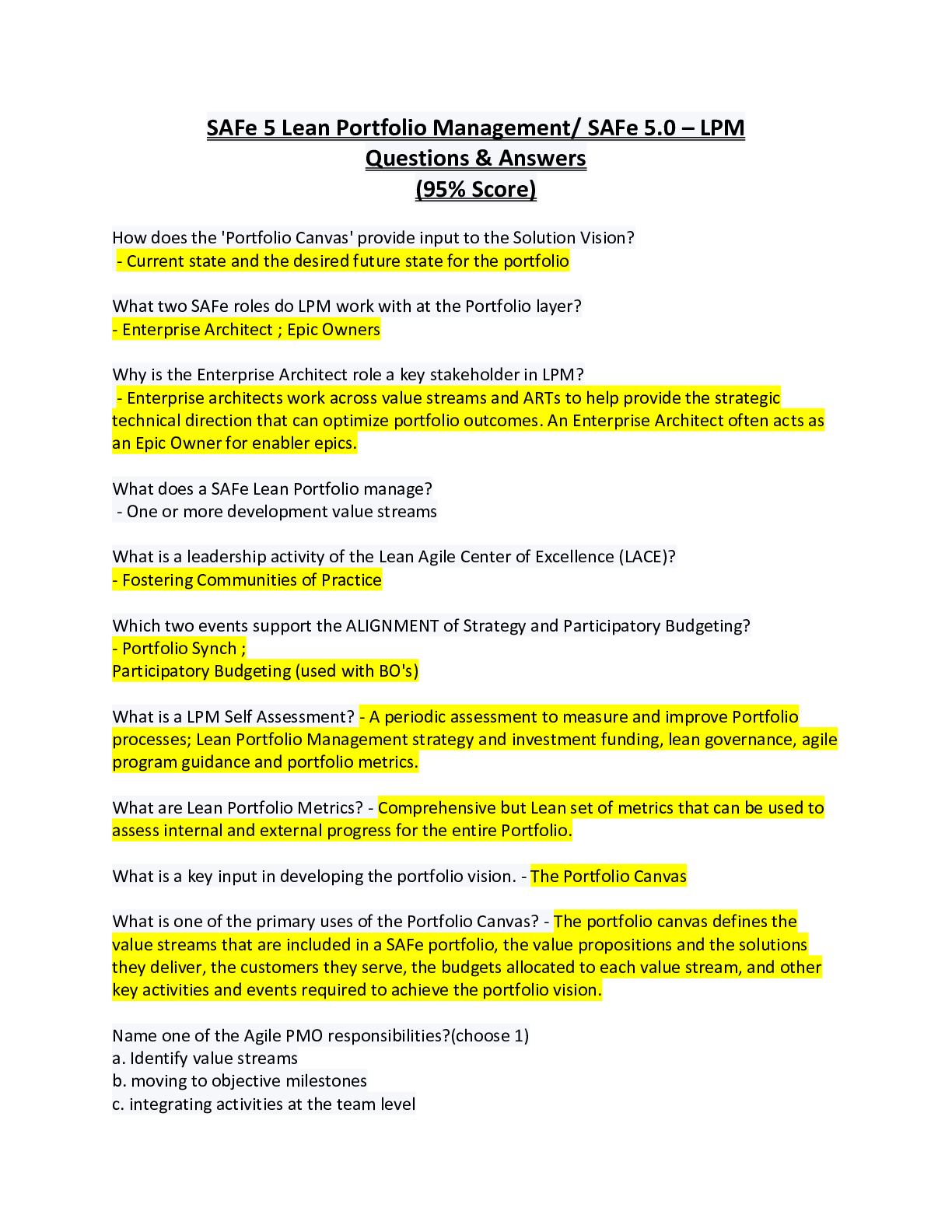

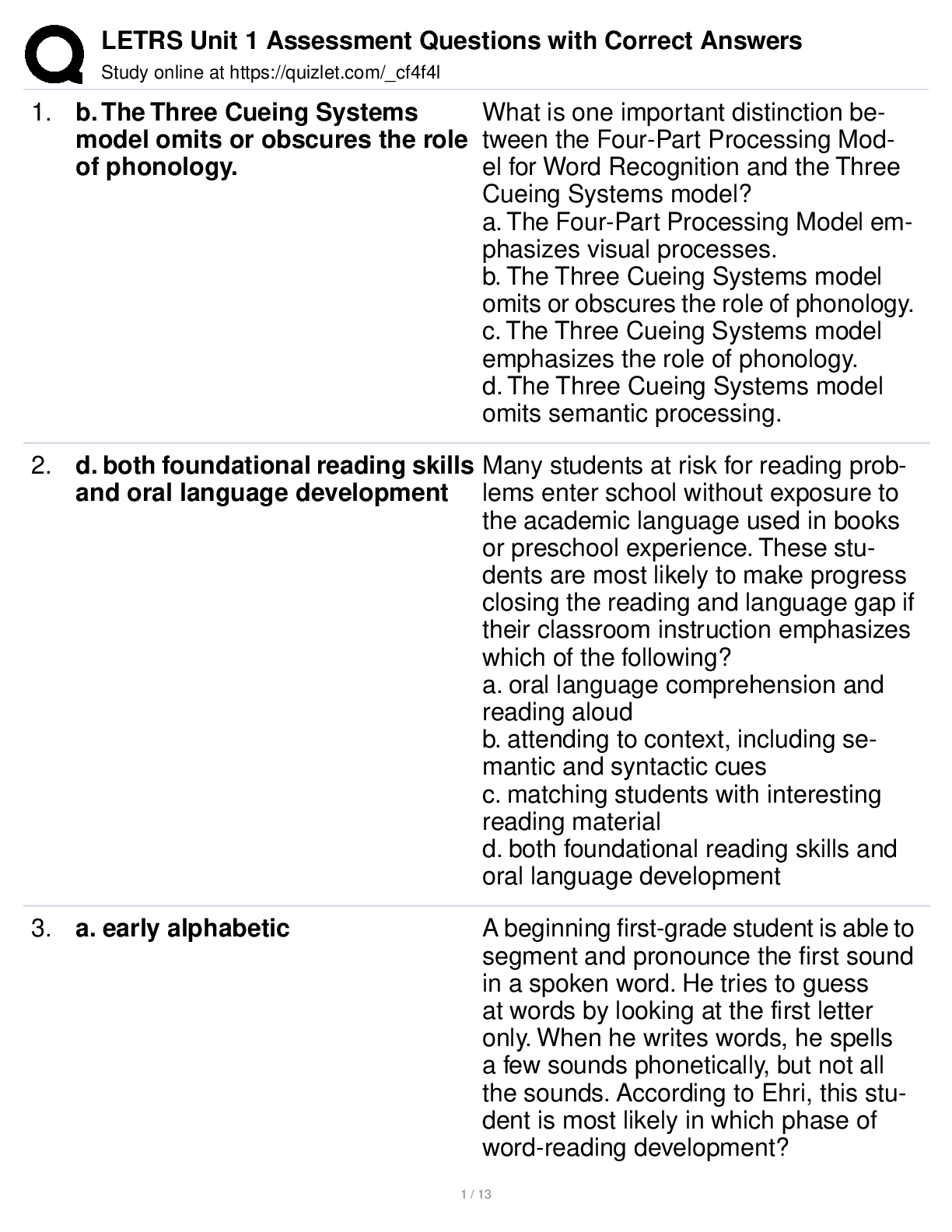


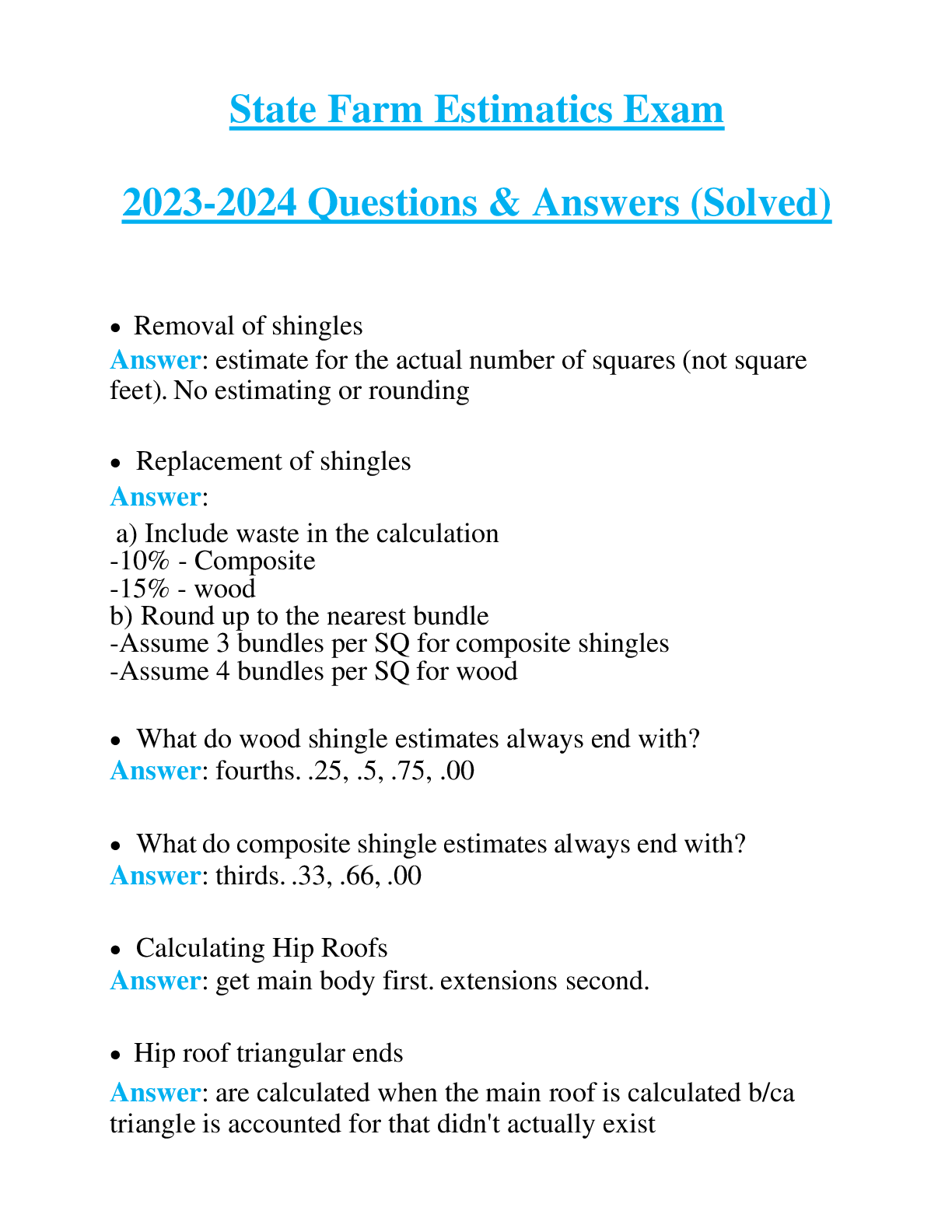
.png)



